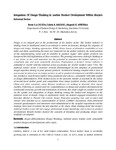| dc.description.abstract | Design is an integral part of the productivity of the leather sector. The leather industry is shifting from its traditional roots in an attempt to revive its fortunes, through the adoption of design and design thinking approaches. While Kenya boasts of abundant availability of raw hides and skins, constituting the main raw materials for the leather industry, the weak position of the manufacturing sector and its inability to produce higher value-added products has hampered the full exploitation of these resources. The growing awareness of design thinking as a key driver in the craft industries has the potential to transition the leather industry in a completely new and more sustainable direction. Employment in Kenya’s leather industry is estimated at 14,000 with the informal sector accounting for 10,000 workers (over 71%). The informal leather sector is however severely disadvantaged by low adoption of professional design expertise leading to poor quality products. Insufficient funding coupled with a lack of access and/or awareness on design services to aid in product development and differentiation has resulted in most Kenyan leather being produced and sold as a commodity with little quality or design differentiation. With limited access to the domestic market occasioned by the influx of second-hand leather goods and competition from cheap/synthetic leather substitutes from China and other countries, many Kenyan producers are seeking to diversify their export markets. Following an urgent need for competitiveness in design and product development for accelerated economic growth and eradication of poverty, this study sought to conduct an audit on the uptake and integration of design thinking among the leathercraft designers in the informal sector in Kenya. Using an exploratory study, the authors engaged respondents from Kariokor Market in Nairobi City County, Kenya. Purposive sampling was used to select stall owners who doubled up as representatives of Kenya Cobblers Association. Semi-structured research questionnaires and interviews were administered to the sampled respondents and the findings were used to answer the key objective of the study. Study findings show that Kenya’s informal leather sector did not engage professional design knowledge and services in product development. Results further showed the concepts of branding and packaging design were similarly not adopted. | en_US |

